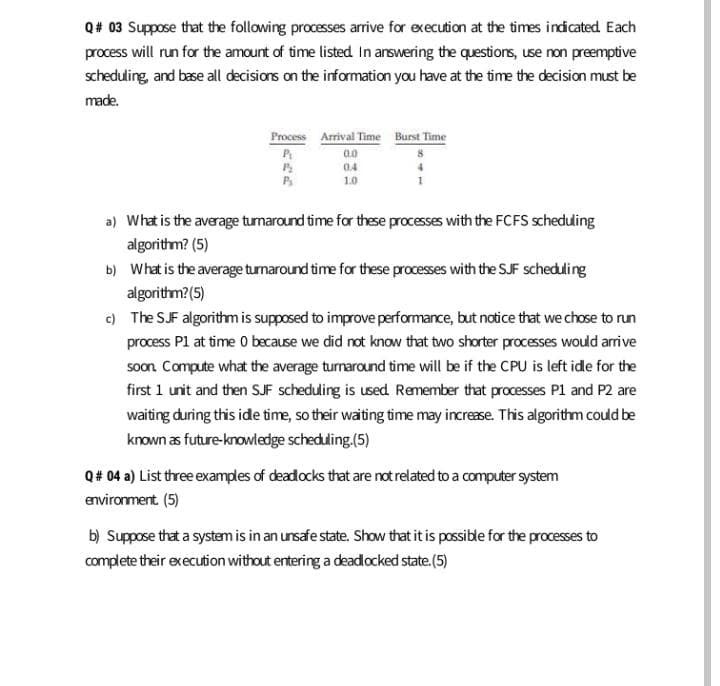Q# 03 Suppose that the following processes arrive for execution at the times indicated Each process will run for the amount of time listed In arswering the questions, use non preemptive scheduling, and base all decisions on the information you have at the time the decision must be made. Process Arrival Time Burst Time 00 04 10 a) What is the average turnaround time for these processes with the FCFS scheduling algorithm? (5) b) What is the average turnaround time for these processes with the SJF scheduling algorithm?(5) c) The SJF algorithmis supposed to improve performance, but notice that we chose to run process P1 at time 0 because we did not know that two shorter processes would arrive soon Compute what the average turnaround time will be if the CPU is left ide for the first 1 unit and then SJF scheduling is used Remember that processes P1 and P2 are waiting during this ide time, so their waiting time may increase. This algoritm could be known as future-knowledge scheduling (5) Q# 04 a) List three examples of deadocks that are not related to a computer system enviroment. (5) b) Suppose that a system is in an unsafe state. Show that it is possible for the processes to complete their execution without entering a deadocked state.(5)
Q# 03 Suppose that the following processes arrive for execution at the times indicated Each process will run for the amount of time listed In arswering the questions, use non preemptive scheduling, and base all decisions on the information you have at the time the decision must be made. Process Arrival Time Burst Time 00 04 10 a) What is the average turnaround time for these processes with the FCFS scheduling algorithm? (5) b) What is the average turnaround time for these processes with the SJF scheduling algorithm?(5) c) The SJF algorithmis supposed to improve performance, but notice that we chose to run process P1 at time 0 because we did not know that two shorter processes would arrive soon Compute what the average turnaround time will be if the CPU is left ide for the first 1 unit and then SJF scheduling is used Remember that processes P1 and P2 are waiting during this ide time, so their waiting time may increase. This algoritm could be known as future-knowledge scheduling (5) Q# 04 a) List three examples of deadocks that are not related to a computer system enviroment. (5) b) Suppose that a system is in an unsafe state. Show that it is possible for the processes to complete their execution without entering a deadocked state.(5)
Chapter11: Operating Systems
Section: Chapter Questions
Problem 20VE
Related questions
Question

Transcribed Image Text:Q# 03 Suppose that the following processes arrive for execution at the times indicated Each
process will run for the amount of time listed In answering the questions, use non preemptive
scheduling, and base all decisions on the information you have at the time the decision must be
made.
Process Arrival Time Burst Time
00
0.4
1.0
a) What is the average tunaround time for these processes with the FCFS scheduling
algorithm? (5)
b) What is the average turnaround time for these processes with the SJF scheduling
algorithm? (5)
c) The SJF algorithmis supposed to improve performance, but notice that we chose to run
process P1 at time 0 because we did not know that two shorter processes would arive
soon Compute what the average turnaround time will be if the CPU is left ide for the
first 1 unit and then SJF scheduling is used Remember that processes P1 and P2 are
waiting during this ide time, so their waiting time may increase. This algorithm could be
known as future-knowledge scheduling.(5)
Q# 04 a) List three examples of deadocks that are not related to a computer system
environment. (5)
b) Suppose that a system is in an unsafe state. Show that it is possible for the processes to
complete their execution without entering a deadocked state.(5)
Expert Solution
This question has been solved!
Explore an expertly crafted, step-by-step solution for a thorough understanding of key concepts.
This is a popular solution!
Trending now
This is a popular solution!
Step by step
Solved in 2 steps

Knowledge Booster
Learn more about
Need a deep-dive on the concept behind this application? Look no further. Learn more about this topic, computer-science and related others by exploring similar questions and additional content below.Recommended textbooks for you

Systems Architecture
Computer Science
ISBN:
9781305080195
Author:
Stephen D. Burd
Publisher:
Cengage Learning

Systems Architecture
Computer Science
ISBN:
9781305080195
Author:
Stephen D. Burd
Publisher:
Cengage Learning